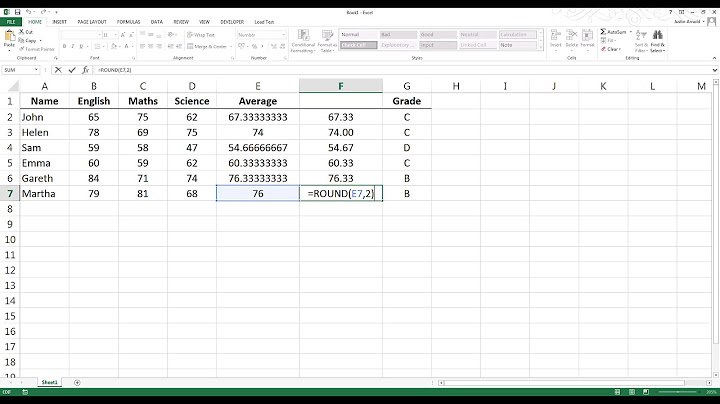How to get numbers after decimal point?
282,189
Solution 1
An easy approach for you:
number_dec = str(number-int(number))[1:]
Solution 2
5.55 % 1
Keep in mind this won't help you with floating point rounding problems. I.e., you may get:
0.550000000001
Or otherwise a little off the 0.55 you are expecting.
Solution 3
Use modf:
>>> import math
>>> frac, whole = math.modf(2.5)
>>> frac
0.5
>>> whole
2.0
Solution 4
What about:
a = 1.3927278749291
b = a - int(a)
b
>> 0.39272787492910011
Or, using numpy:
import numpy
a = 1.3927278749291
b = a - numpy.fix(a)
Solution 5
Using the decimal module from the standard library, you can retain the original precision and avoid floating point rounding issues:
>>> from decimal import Decimal
>>> Decimal('4.20') % 1
Decimal('0.20')
As kindall notes in the comments, you'll have to convert native floats to strings first.
Related videos on Youtube
Author by
Alex Gordon
Check out my YouTube channel with videos on Azure development.
Updated on May 06, 2022Comments
-
Alex Gordon about 2 years
How do I get the numbers after a decimal point?
For example, if I have
5.55, how do i get.55?-
ire_and_curses over 13 years
-
Gulzar almost 3 yearsI think you should change the accepted answer on this. I almost didn't scroll down to the x10 times voted answer, and this would have bitten me later.
-
 Abimael Domínguez over 2 yearsI think this is a simple approach:
Abimael Domínguez over 2 yearsI think this is a simple approach:float( '0.' + str(5.55).split('.')[1] )>>> 0.55. But if someone thinks different, please let me know.
-
-
ire_and_curses over 13 yearsIf you're going to
import math, why not just usemath.modf()? -
 Admin over 13 years@ire_and_curses: I am providing an alternative solution to the problem.
Admin over 13 years@ire_and_curses: I am providing an alternative solution to the problem. -
kindall over 13 yearsFor the benefit of the original question-asker: floats must be converted to a strings before they can be converted to Decimals. So if you have
n = 5.55, n is a float, and you should doDecimal(str(n)) % 1to get the fractional part. (This isn't necessary if you have an integer, but it doesn't hurt.) -
kindall over 13 yearsThis is OK for garden-variety numbers, but doesn't work so well for numbers large (or small) enough to require scientific notation.
-
bereal about 12 yearsAs for
modf, it can screw the precision as well:math.modf(5.55)will return (0.5499999999999998, 5.0). -
hokkuk over 11 yearsdoes anyone know which would be the faster operation, this method described above, or: float b = a - int(a) ? i suspect the later, but wanted to see if there was confirmation
-
intuited over 11 yearsExercise for the reader: make it work for numbers larger than or equal to 10
-
aherok about 11 years@intuited: It doesn't need to be decimal, it works also for float:
10.0/3 % 1at least on my system -
 QuantumKarl almost 11 yearsfloor does the same as casting to a int so could replace math.floor(t) with int(t)
QuantumKarl almost 11 yearsfloor does the same as casting to a int so could replace math.floor(t) with int(t) -
Volatil3 about 10 yearsIf you want to omit decimal point then simply do this
number_dec = str(n-int(n))[2:] -
Ryan Allen about 10 years
number_dec = str(number-int(number)).split('.')[1] -
Kyle Heuton almost 10 years@intuited I was confused by your comment- this answer should work fine for numbers over 2 digits. You wont run into floating point issues until 2^14 (16384) for 2 decimal places, 2^13 (8192) for 3 decimal places, and so on.
-
Matthew Purdon over 9 yearsYou can use from_float instead of using a string. d = Decimal.from_float(1.2)
-
 Stew over 9 yearsDownvote because this is an unnecessarily complicated approach. The answer I sought was the next answer,
Stew over 9 yearsDownvote because this is an unnecessarily complicated approach. The answer I sought was the next answer,5.55 % 1, which is also a more generally useful answer--one can use the modulo division approach in multiple languages, whereas the above answer is Python-specific. -
macm about 9 years>>> frac 0.5499999999999998
-
 T. Christiansen about 9 yearsNOTE: This solution returns a string including the dot (
T. Christiansen about 9 yearsNOTE: This solution returns a string including the dot (.55), which you may not expect due the questions title! -
Lambda Fairy about 8 years@QuantumKarl No, they are different.
math.floor(-1.1) == -2butint(-1.1) == -1. Though for this question usingintis more correct. -
 garg10may about 8 years@intuited still looking for that solution? any idea
garg10may about 8 years@intuited still looking for that solution? any idea -
 Igor Soloydenko almost 8 yearsString based solutions are horrible if performance is important for your app.
Igor Soloydenko almost 8 yearsString based solutions are horrible if performance is important for your app. -
 D1X over 7 years@intuited How does one obtain the decimal part as an integer? I have tried to_integer() methods but the type is still Decimal.
D1X over 7 years@intuited How does one obtain the decimal part as an integer? I have tried to_integer() methods but the type is still Decimal. -
 coderforlife over 7 yearsOn a Raspberry Pi this method
coderforlife over 7 yearsOn a Raspberry Pi this methodx%1was almost twice as fast as thex-int(x)andmodf(x)[0]methods (the timings were 980ns, 1.39us, and 1.47us averaged over 1000000 runs). My value forxwas always positive so I did not have to worry about that. -
 Admin about 7 yearsAny explanation?
Admin about 7 yearsAny explanation? -
 Priyank Mehta almost 7 years@Anthony Vallone answer is cleaner and correct approach
Priyank Mehta almost 7 years@Anthony Vallone answer is cleaner and correct approach -
Cristian Ciupitu almost 7 years
str(5.55 - int(5.55))[1:]returns.5499999999999998instead of the.55mentioned in the question. -
 Enrico Borba over 6 yearsDefinitely the module operation is faster. It doesn't have to do any name lookups. Whereas calling the int function does a lookup on the global variables.
Enrico Borba over 6 yearsDefinitely the module operation is faster. It doesn't have to do any name lookups. Whereas calling the int function does a lookup on the global variables. -
 Meow over 6 yearsThis is nice because it return a non-fractional value, but will break on negative numbers
Meow over 6 yearsThis is nice because it return a non-fractional value, but will break on negative numbers -
ZF007 about 6 yearsThe shortest and correct answer is posted here. The solution posted here is regardless of float/int subtracting "number - number" and result in null or zeros or 0.0!
-
user207421 almost 6 yearsUnfortunately it doesn't work most of the time. @Meow
-
Pedro Alves over 5 yearsThis is a real bad practice. Shouldn't be recommended as the accepted answer.
-
Lord Loh. over 5 yearsGood solution, but,
math.modf(2.53) = (0.5299999999999998, 2.0)expected answer is 0.53 -
Mark Dickinson over 5 years
number = 5.55; "." in numbergivesTypeError: argument of type 'float' is not iterable. And what would you do ifnumber = 1e-5? -
yosemite_k over 5 years@mark the question is How do I get the numbers after a decimal point? so user is expecting float in decimal notation (not scientific notation), I've added a block for scientific notation too
-
Mark Dickinson over 5 yearsA number is a number; it's only representations of a number that might be in scientific notation. So "float in decimal notation" doesn't make much sense here; by the time Python sees it, it's just a
float; Python doesn't keep any knowledge of what format it was originally expressed in. Mynumber = 1e-5example applies equally well tonumber = 0.00001: thestrrepresentation of the number is in scientific notation. You'll want to deal withe+as well ase-, by the way. -
 Rena over 5 years@LordLoh. that's because of floating point rounding, and will happen with any method.
Rena over 5 years@LordLoh. that's because of floating point rounding, and will happen with any method. -
Alex Gordon about 5 yearswhat does the operator // mean?
-
SirJ about 5 years@LordLoh. Try to use round(0.5299999999999998 , 2) to get 0.53 Another way is to use Decimal from decimal package. docs.python.org/2/library/decimal.html
-
John Y over 4 years@MatthewPurdon - If you use
Decimal.from_float(1.2)(which can now be written asDecimal(1.2)) you will have rounding issues, which this answer was trying to avoid. -
 mckenzm about 4 yearsfancy not just having a frac()
mckenzm about 4 yearsfancy not just having a frac() -
 Aditya Patnaik almost 4 yearswhat does this do for 0.000005?
Aditya Patnaik almost 4 yearswhat does this do for 0.000005? -
Rasmus Damgaard Nielsen almost 4 yearsAnother reason this is bad: I'm european, and here str will give 5,55 (we use comma). So the code is also needlessly restricted to american users.
-
 Kyoujin almost 4 yearsThis works perfectly, but could anyone explain why it works?
Kyoujin almost 4 yearsThis works perfectly, but could anyone explain why it works? -
jer almost 4 yearsThe % operator is the modulo operator, and rather than explain it in great detail here, I'll link an article instead. jquery-az.com/python-modulo
-
run_the_race over 3 yearsCan test the speed with:
from timeit import timeit iterations = 1000000 result = timeit( 'n = 765.126357123; x = n -floor(n)', 'from math import floor', number=iterations ) print("Total time was:", result) print("Time per iterations was:", result/iterations) -
M. Lautaro about 3 yearsBeware this breaks on negative numbers.
-
 khanh about 3 yearsDownload because this is an unnecessarily complicated approach despite having simpler method.
khanh about 3 yearsDownload because this is an unnecessarily complicated approach despite having simpler method. -
Evgeni Sergeev almost 3 years@Rena More precisely: "... and will happen for any method where the result has to be given as an IEEE 754 double-precision float."
-
 eric over 2 years@M.Lautaro it depends what behavior you want with negative numbers. E.g., for
eric over 2 years@M.Lautaro it depends what behavior you want with negative numbers. E.g., for-2.5do you want the algorithm to return-0.5or0.5? OP didn't specify. For my use case, I am fine with the former, so this works great. -
Alejo about 2 yearsThis is the real solution
-
Alejo about 2 yearsfloat("0."+str(number).split('.')[1])









